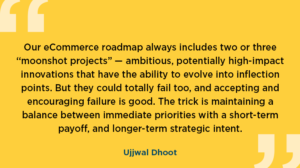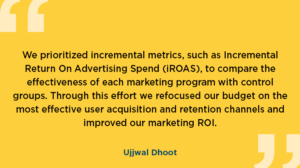2020 may be over, but the transformations brought about by COVID-19 are here to stay.
As the gap between brick-and-mortar and online retail grows ever smaller, omnichannel retailers stand to win big if they can adapt to new customer demands.
We interviewed Ujjwal Dhoot, Chief Marketing Officer at Destination XL Group (DXL), the leading omnichannel big and tall men’s clothing retailer in the United States.
DXL pulled through this exceptional year by riding the wave of change in consumer behavior, putting user experience front and center while prioritizing spending to drive long-term sustainability.
Ujjwal explained to Lauren Bermudez, our Director of Field Marketing, his vision of the future – and what omnichannel retailers must do to stay ahead of the curve:
Lauren: When it comes to customer experience, what are the biggest ways you feel customers’ needs have changed over the past few years?
Ujjwal: It’s worth focusing on the macro economic and lifestyle changes that occurred in this past year. Last summer McKinsey published a report about how eCommerce sales growth accelerated by ten years in the first one hundred days of the pandemic. Millions of people, notably older demographics who used to spend little time digitally, became first-time shoppers overnight and embraced the new “forced” way.
We certainly expect this unprecedented surge will continue even as the pandemic subsides. Many consumers have seen how much convenience online shopping introduces. As omnichannel retailers, we will continue to invest in our digital capabilities to deliver a seamless transition and focus on the customer instead of channel-based shopping.
Lauren: How do you feel customer experience expectations will change the most over the next year?
Ujjwal: Everything is evolving much faster in the eCommerce space. A year ago, ideas like virtual shopping appointments or personalization were cutting-edge and could provide a real competitive advantage. Today, those features are becoming the new table stakes, and companies who don’t experiment with adopting them will be left behind.
The new eCommerce winners will be the players who can innovate to provide a better experience across multiple buying mechanisms. We believe more retailers will move to omnichannel distribution and marketing.
Lauren: What aspect of the online customer journey still needs improvement?
Ujjwal: There’s still a long way to go. It’s a constant layering of data and ideas to continue to improve our understanding of the factors that most influence the customer journey. It’s even more critical to make marketing dollars work harder to deliver accurate, measurable conclusions about customer needs. I expect tremendous developments in consumer analytics in the post COVID-19 context.
Lauren: What is one valuable yet often overlooked opportunity that eCommerce managers should focus on that can improve the online shopping experience for customers?
Ujjwal: Exciting innovations like AI, AR and the development of Web 3.0 mean more opportunities for differentiation and they’re all part of the long-term roadmap to experiment and learn. That being said, it’s essential to focus on the fundamentals of online retail — a high quality online storefront, a seamless omnichannel user experience, new ways to merchandise, effective marketing funnels to drive and convert traffic, and tools to measure customer intent.
It’s tempting to think we understand customer preferences and brand perception based on a few conversations with customers, but any company is vulnerable to cognitive bias. How do you constantly monitor the evolving customer experiences, how they create perceptions, how that changes their behavior and what influences them the most? Then, we need to try to validate all our understanding (and assumptions) about our customers and base our decisions on data.
Lauren: How do you prioritize your eCommerce projects?
Ujjwal: We use a simple prioritization framework. We take into account effort required and estimated short- and-long-term business impact. In a playing field as competitive as ours, innovation is key to attract first-time shoppers, and that means dreaming big.

Lauren: Which online KPIs do you think will become even more important to focus on when measuring success for your company?
Ujjwal: While we monitor the fundamental KPIs – conversion rate, traffic and the like – our key objective is to accurately understand how many customers we can move to engage with our brand across multiple buying mechanisms and buy online, on the app and in stores.
We pay very close attention to the proportion of shoppers purchasing across multiple mechanisms — our most valuable customer segment by several increments.
Lauren: If you had to give one piece of advice to other eCommerce retailers on how to emerge successfully from the pandemic, what would it be?
Ujjwal: Listen to your customers. Solicit their feedback, challenge your assumptions and make customers really matter to you by changing your marketing based on their input. Be sure to develop your analytics capabilities to gain insights on their behaviors.
Lauren: Which eCommerce strategy has best helped you address COVID-19 challenges; do you expect it to be critical after the pandemic is over?
Ujjwal: When the pandemic hit, our priority was to continue serving a customer need while sparing no effort in keeping customers and our employees safe. We very quickly pivoted and set up omnichannel solutions such as BOPIS (Buy Online, Pickup in Store) and curbside pickup, which our customers greatly appreciated. We started serving customers from stores near them, shipping much quicker and taking the stress off our Distribution Center. We navigated the transition effectively, and I’m confident these innovations will remain popular as restrictions lift and retailers try to increase flexibility in their operations.
Another important domain of development has been performance indicators. COVID-19 drove us to eliminate unnecessary expenses and make sure every marketing dollar spent goes toward driving an outcome.

Lauren: How much of a role do promotions and incentives play in your current strategy?
Ujjwal: Promotions will continue to be part of successful retail strategies – as long as they’re used strategically. This is a lesson we learned from COVID-19: when it comes to promotions, it’s not about giving everyone everything, all the time, across all buying mechanisms. We adopted a test-and-learn approach to determine the promotions most suited to each customer segment, and quickly obtained actionable results. Segmentation-based promotions provide valuable data while having customers feel they’re receiving a personalized message.
Lauren: How much of a difference do you think being able to analyze customers’ intent can make when it comes to getting the most of your promotional spend, and how much can this help in capturing first-time shoppers?
Ujjwal: The most effective way to analyze customer intent is to measure outcomes, not correlations – the “how” and “why” rather than the “what”.
The simplest example is the revenue from an outcome, how many customers bought — that’s the “what”. Only by looking at why a customer redeemed a coupon, or how many more customers acted compared to a control group, or how customers behave differently as measured over time in cohorts — can we understand true customer intent.
Stay tuned for our upcoming case study with DXL and learn how eliminating Customer Journey Hijacking has markedly lifted their conversion and RPV.
Gaining clear and swift ROI is more important in 2021 than ever. Find out how you can clear the path to purchase and immediately increase revenue with Namogoo’s Digital Journey Continuity platform.



